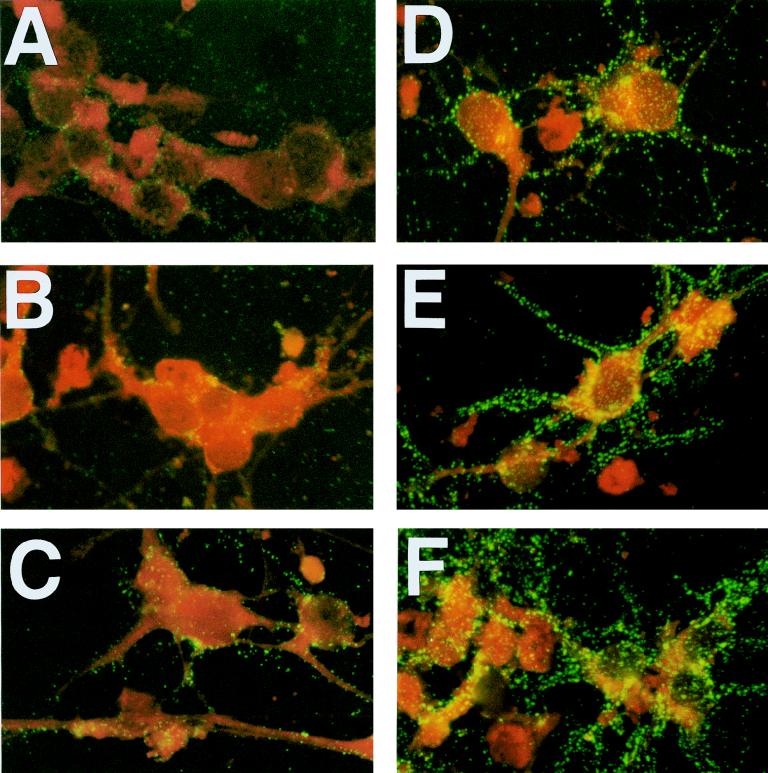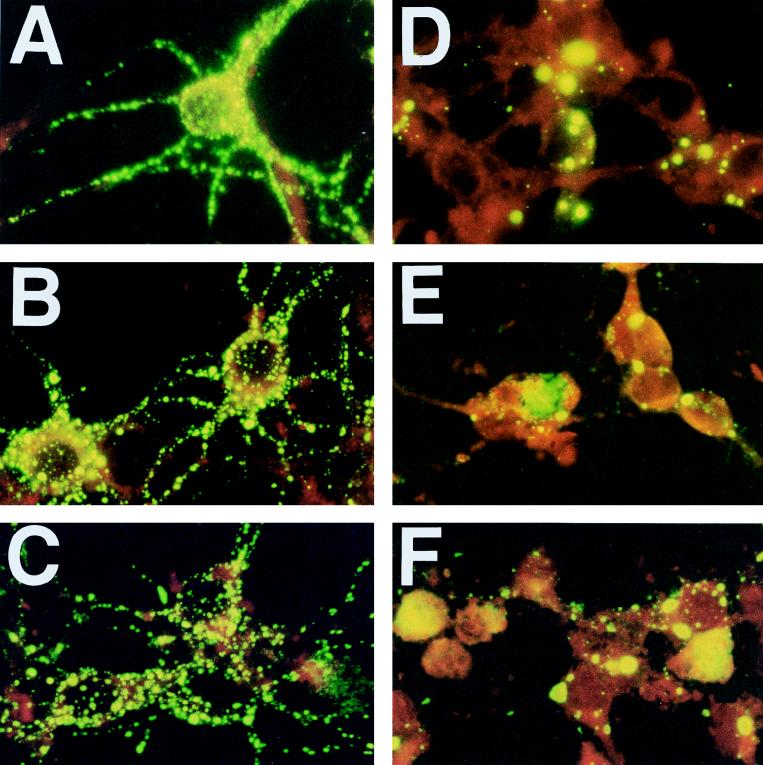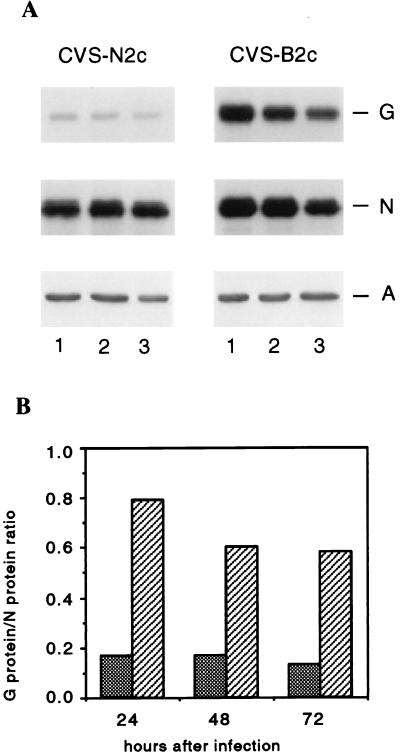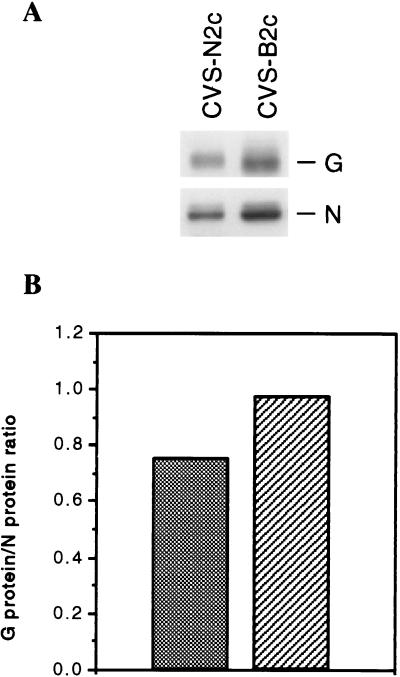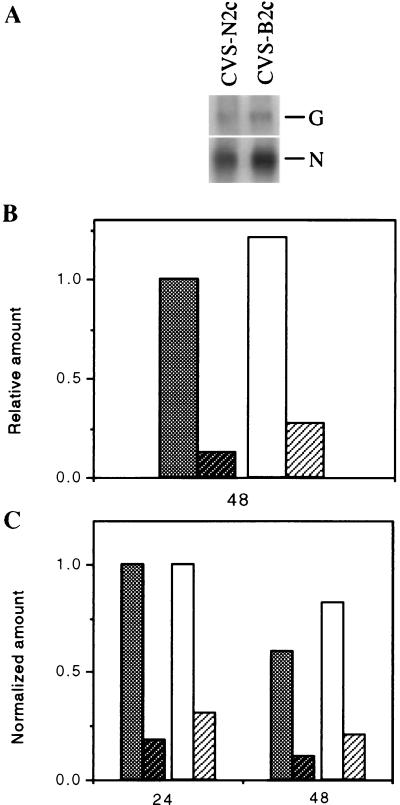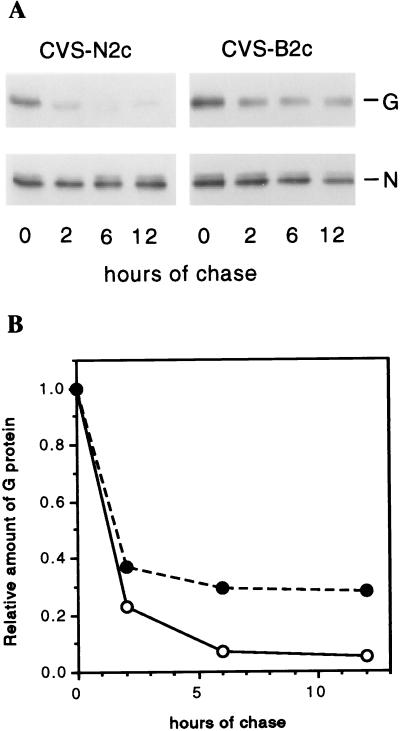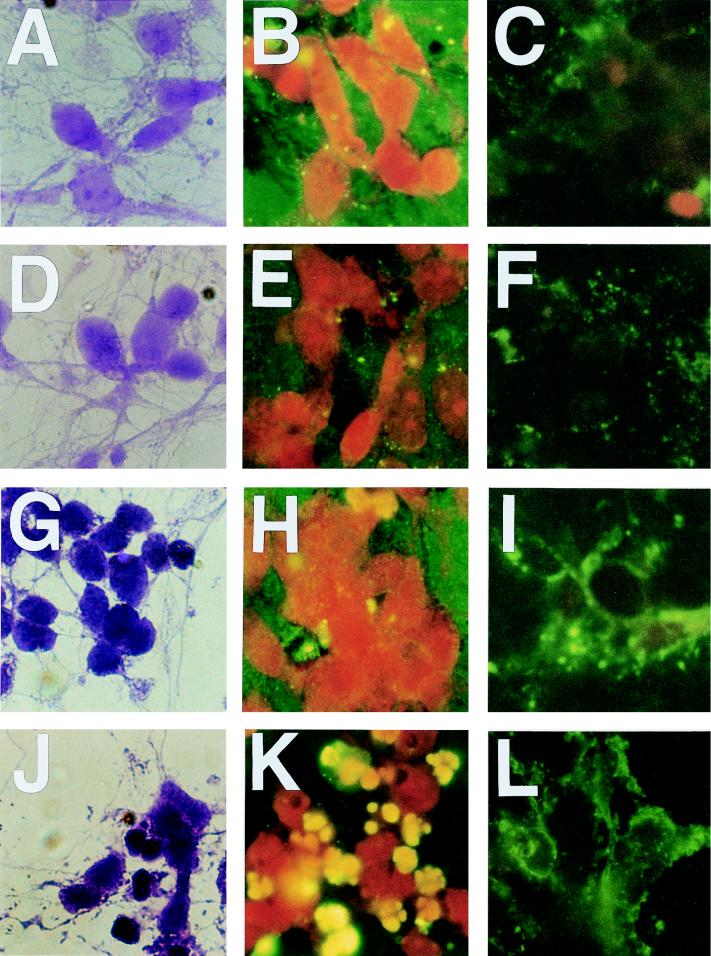Abstract
The mouse-adapted rabies virus strain CVS-24 has stable variants, CVS-B2c and CVS-N2c, which differ greatly in their pathogenicity for normal adult mice and in their ability to infect nonneuronal cells. The glycoprotein (G protein), which has previously been implicated in rabies virus pathogenicity, shows substantial structural differences between these variants. Although prior studies have identified antigenic site III of the G protein as the major pathogenicity determinant, CVS-B2c and CVS-N2c do not vary at this site. The possibility that pathogenicity is inversely related to G protein expression levels is suggested by the finding that CVS-B2c, the less pathogenic variant, expresses at least fourfold-higher levels of G protein than CVS-N2c in infected neurons. Although there is some difference between CVS-B2c- and CVS-N2c-infected neurons in G protein mRNA expression levels, the differential expression of G protein appears to be largely determined by posttranslational mechanisms that affect G protein stability. Pulse-chase experiments indicated that the G protein of CVS-B2c is degraded more slowly than that of CVS-N2c. The accumulation of G protein correlated with the induction of programmed cell death in CVS-B2c-infected neurons. The extent of apoptosis was considerably lower in CVS-N2c-infected neurons, where G protein expression was minimal. While nucleoprotein (N protein) expression levels were similar in neurons infected with either variant, the transport of N protein into neuronal processes was strongly inhibited in CVS-B2c-infected cells. Thus, downregulation of G protein expression in neuronal cells evidently contributes to rabies virus pathogenesis by preventing apoptosis and the apparently associated failure of the axonal transport of N protein.
Accumulating evidence indicates that the rabies virus glycoprotein (G protein) plays an essential role in the pathogenicity of the virus. For example, the pathogenicity of the tissue culture-adapted rabies virus strains ERA, HEP, and CVS has been shown to correlate with the presence of a determinant located in antigenic site III of the G protein (5, 18). Variants with an Arg→Glu mutation at position 333 in site III of the G protein are less pathogenic for immunocompetent adult mice than the wild-type parental viruses (5, 18). The greatly reduced spread of these antigenic site III mutants within the nervous system (6) indicates that the appropriate G protein structure is absolutely essential for the rapid axonal/transsynaptic spread of rabies virus that leads to a lethal infection in adult animals. Based on these findings, one might expect that site III mutations are the single most important indicator of decreased pathogenicity. However, by comparison with street rabies virus strains, rabies virus strains adapted to nonneuronal cells in vitro, such as ERA, are already highly attenuated with respect to pathogenicity for immunocompetent mammals (15), despite having an unchanged antigenic site III. Thus, the pathogenicity phenotype of a particular rabies virus strain is determined not only by the determinants located in antigenic site III of the G protein but also by other mechanisms which may or may not be related to the G protein. We recently found that the mouse brain-adapted CVS-24 strain of rabies virus consists of two phenotypically and genotypically distinct variants, CVS-B2c and CVS-N2c (16). The amino acid sequences of the nucleoproteins (N proteins) of both variants are identical, whereas the G proteins of CVS-B2c and CVS-N2c differ in 10 amino acids outside antigenic site III. While CVS-N2c is the dominant variant when CVS-24 is passaged in mouse brain or neuroblastoma cells, passage in baby hamster kidney (BHK-21) cells results in rapid selection of the CVS-B2c variant. CVS-N2c replicates more readily in neuronal cells, whereas CVS-B2c replicates better in nonneuronal cells. For normal adult mice, the pathogenicity index (defined as the 50% lethal dose of a particular virus stock preparation divided by the virus titer) of CVS-N2c is up to 50 times higher than that of CVS-B2c, depending on the route of inoculation (16). The disparity in the pathogenicities of these two variants must therefore depend either on differences outside site III in the G protein or on other factors that determine the capacity of the virus to invade, replicate, spread in neuronal tissue, and produce neurological disease.
In the present study, we used variants CVS-N2c and CVS-B2c as probes to examine the mechanisms involved in rabies virus neuropathogenicity. We demonstrated that G protein expression in infected primary neuron cultures is different between the two variants and that the downregulation of G protein expression in neurons is associated with increased pathogenicity.
MATERIALS AND METHODS
Cells and viruses.
NA neuroblastoma cells of A/J mouse origin were grown at 37°C in Eagle’s minimum essential medium supplemented with 10% heat-inactivated fetal bovine serum (FBS). Primary neuron cultures were prepared from the hippocampi of prenatal Swiss Webster mice (day 17 of gestation) as described previously (2). Briefly, the isolated hippocampi were treated for 15 min at 37°C with 4 ml of 0.04% trypsin. After the addition of 5 ml of Dulbecco’s minimal essential medium (GIBCO BRL, Grand Island, N.Y.) and 1 ml of FBS, cells were dispersed with a pipette with a heat-polished tip and strained through a Falcon cell strainer. Cells were layered on a 2-ml FBS cushion and centrifuged for 5 min at 1,000 rpm, and the pelleted cells were resuspended in Neurobasal medium (GIBCO BRL) at a concentration of 5 × 105 cells/ml. Cells (250 μl) were then plated on 18-mm round polylysine-coated coverslips and incubated in a 5% CO2 atmosphere for 1 h at 37°C, and the coverslips were placed on a layer of astrocytes isolated from the brains of 2-day-old Swiss Webster mice and cultured in 10-cm-diameter petri dishes as described previously (4). The primary neurons grown on coverslips were more than 95% pure, as judged by size, morphology, and immunostaining for the panneuronal marker protein PGP9.5. After 2 days of culturing in Neurobasal medium, neurons were infected with the CVS-24 variants CVS-N2c and CVS-B2c at a multiplicity of infection (MOI) of 1, which resulted in infection of more than 90% of the neurons within 24 h postinfection (p.i.), as determined by staining with N protein-specific antibodies. Isolation and characterization of these variants have been described elsewhere (16). Because CVS-B2c replicates better in nonneuronal cells than CVS-N2c and the latter does not cause plaques in nonneuronal cells, the titers of both viruses were determined with mouse neuroblastoma cells and the fluorescent-focus assay.
Immunofluorescence analysis.
Neurons were fixed in 80% acetone at 24, 48, and 72 h p.i. To detect N protein, fixed neuron cultures were subjected to a direct fluorescence staining technique with fluorescein isothiocyanate (FITC)-labeled anti-rabies virus N protein-specific mouse monoclonal antibody (MAb) (Centocor, Malvern, Pa.) as described previously (7). To detect G protein, fixed neuron cultures were incubated with a monospecific rabbit antibody that recognizes rabies virus G protein, and reactions were visualized with FITC-labeled goat anti-rabbit immunoglobulin G (Sigma, St. Louis, Mo.). Evans blue was used as a counterstain and appeared red under green fluorescence.
Immunoprecipitation.
Primary mouse neuron cultures were infected with CVS-B2c or CVS-N2c at an MOI of 1. At 2, 24, or 48 h p.i., the culture medium was replaced with methionine-free Neurobasal medium containing 10 μCi of [35S]methionine/ml, and incubation was continued for 24 h at 37°C. Cells were then lysed with lysis buffer (10 mM Tris-HCl [pH 7.4], 150 mM NaCl, 1% Triton X-100, 0.5% sodium deoxycholate), protein content was determined, and lysates were calibrated to the same protein concentration (400 μg/ml). Two micrograms of G protein-specific MAb 6-15c (kindly provided by A. Osterhaus, Institute of Virology, Erasmus University Hospital, Rotterdam, The Netherlands), 2 μg of N protein-specific MAb 377-7 (7), or 2 μg of actin-specific antibody was added to 400 μl of lysate, and the mixtures were incubated overnight at 4°C. The resulting immune complexes were adsorbed to protein A-Sepharose beads. After the beads were washed with lysis buffer containing 0.45% sodium dodecyl sulfate (SDS), the precipitated proteins were solubilized in a small volume of SDS sample buffer and subjected to electrophoresis on an SDS–10% polyacrylamide gel. The gel was dried and exposed to X-ray film, and protein bands were quantitated by densitometry with the NIH 1.58 IMAGE program.
Pulse-chase analysis.
Primary neuron cultures were infected with CVS-B2c or CVS-N2c at an MOI of 1. At 24 h p.i., the cells were pulse-labeled for 1 h with 50 μCi of [35S]methionine/ml. The medium was then replaced with Neurobasal medium containing 2 mM unlabeled methionine. After 2, 6, and 12 h of chase with unlabeled methionine, neurons were lysed, and the lysates were subjected to immunoprecipitation with G or N protein-specific MAbs. Proteins were analyzed by SDS-polyacrylamide gel electrophoresis as described above.
RNA extraction and Northern blot analysis.
Total RNA was isolated from infected neuron cultures by the RNAzol B method (Biotex Laboratories, Inc., Houston, Tex.). For Northern blot analysis, aliquots containing 7.5 μg of RNA were electrophoresed on a 1% agarose gel containing 2.2 M formaldehyde–0.1 M morpholinepropanesulfonic acid (MOPS) buffer (pH 7.0), blotted on Nytran nylon membranes, and hybridized with nick-translated [α-32P]dCTP-labeled cloned N or G protein cDNA as described previously (16). Membranes were exposed to X-ray film, and RNA bands were quantitated by densitometry with the NIH 1.58 IMAGE program.
Quantitative PCR.
Absolute and relative amounts of G and N protein mRNAs produced in CVS-N2c- and CVS-B2c-infected neurons were also assessed by the real-time quantitative PCR method (10). Reverse transcription (RT) reactions were carried out with 2.5 μg of total RNA and 1 μM reverse primer as described previously (16). Serial dilutions of the RT products were then subjected to PCR amplification with forward and reverse primers and a dual-fluorescence dye-labeled probe (FAM-TAMRA). The nucleotide sequences of the probes and primers were as follows: N-reverse primer, 5′-TCATCAGAGTTGACGGTTCCG-3′; G-reverse primer, 5′-TTGATTCATGTCGAGTCCGCT-3′; G3PDH-reverse primer: 5′-AGATGGTGATGGGCTTCCC-3′; N-forward primer, 5′-CAAGAATATGAGGCGGCTGAA-3′; G-forward primer, 5′-GATGACTCTGTGCTTGGGCA-3′; G3PDH-forward primer, 5′-GGCAAATTCAACGGCACAGT-3′; FAM-TAMRA dual-labeled N-probe, 5′-AAAGTCCGACGTGGCACTGGCAGA-3′; FAM-TAMRA dual-labeled G-probe, 5′-AAAGAGGTCGTAGTGTGCCCCCCGA-3′; and FAM-TAMRA dual-labeled G3PDH-probe, 5′-AGGCCGAGAATGGGAAGCTTGTCATC-3′.
The sequences of the N and G mRNA-specific probes and primers are conserved between CVS-N2c and CVS-B2c. Amplification of glyceraldehyde-3-phosphate dehydrogenase (G3PDH) mRNA served as an internal standard. Amplification was carried out for 40 cycles of denaturation at 95°C for 15 s, annealing, and polymerization at 60°C for 1 min with a TaqMan EZ RT-PCR kit (The Perkin-Elmer Corp.). PCR products were detected with the ABI Prism 7700 Sequence Detection System. Standard curves were constructed by plotting CT values (points at which the amplification blot crosses the threshold) against log nanogram amounts of total input RNA. Based on the slope of the standard curves, the total amount of a particular mRNA species was calculated as x = (b − y)/m, where x is the total amount of mRNA, b is the intercept at log 0 ng of RNA, and m is the slope of the standard curves. For y, a CT value of 20 was arbitrarily chosen. To determine the normalized amounts, the relative quantities (reciprocals of the total amounts) of G and N protein mRNAs were divided by the relative quantity of G3PDH mRNA.
In situ terminal end labeling.
The terminal deoxynucleotidyltransferase-mediated dUTP nick end-labeling (TUNEL) method was used to detect DNA strand breaks indicative of apoptotic cell death. At different times after infection, neurons grown on round coverslips were treated with 4% paraformaldehyde in phosphate-buffered saline (PBS) (pH 7.4) for 30 min at room temperature and washed with PBS. A TUNEL assay with propidium iodide counterstain (red-orange) was performed with an Apoptosis Detection System, Fluorescein, in accordance with the manufacturer’s protocol (Promega, Madison, Wis.). Coverslips were mounted with the antifading mounting medium Vectashield (Vector Laboratories) on microslides and examined on a Leitz Microlab microscope under visible and UV illumination.
Annexin V assay.
Primary neuron cultures grown on round glass coverslips were infected with the rabies virus variants and, at 24, 48, and 72 h p.i., washed with 0.1 M HEPES (pH 7.2) and incubated for 10 min with FITC-labeled Annexin V and for 2 min with propidium iodide (APOPTEST-FITC kit; NeXins Research, B. V., Hoeve, The Netherlands) in accordance with the manufacturer’s protocol. Cells were washed again with HEPES buffer and fixed with 4% paraformaldehyde in PBS (pH 7.4) for 30 min at room temperature. Coverslips were mounted with Vectashield on microslides and examined on a fluorescence microscope with the standard setting for FITC fluorescence detection.
RESULTS
Expression of the rabies virus N and G proteins in primary neuron cultures.
Neurons were cultured for 2 days in Neurobasal medium and infected with variant CVS-N2c or CVS-B2c virus at an MOI of 1, which results in optimal infection (more than 90% of the neurons at 24 h p.i.). Immunofluorescence analysis of G protein expression in neurons at 24, 48, and 72 h p.i. revealed intense staining in cell bodies and processes of neurons infected with the CVS-B2c variant (Fig. 1D to F). Much less staining was detected in neurons infected with CVS-N2c (Fig. 1A to C). A similar analysis of N protein expression revealed intense staining in all infected neurons, regardless of the virus variant used for infection (Fig. 2). However, CVS-N2c-infected neurons (Fig. 2A to C) showed a constant fine granular staining pattern which appeared to be more concentrated near the cell surface and which extended into the neuronal processes, whereas CVS-B2-infected neurons (Fig. 2D to F) showed large, discrete N protein-positive inclusion bodies in the cell body cytoplasm and almost no N protein-specific staining in neuronal processes for the first 48 h of culturing. At 72 h p.i., when CVS-B2c-infected neurons had begun to degenerate, large amorphous masses stained positively for the N protein. These data suggest that the N protein is transported into the processes of neurons infected with CVS-N2c but is retained in the cell bodies of CVS-B2c-infected neurons, with minimal peripheral translocation into neuronal processes.
FIG. 1.
Immunofluorescence analysis of G protein expression in primary neuron cultures infected with CVS-N2c (A, B, and C) or CVS-B2c (D, E, and F) virus and examined at 24 (A and D), 48 (B and E), and 72 (C and F) h p.i. Hippocampal neurons isolated from prenatal mouse brains (day 17 of gestation) were seeded on polylysine-coated glass coverslips, which were then placed on top of a cell layer of mouse astrocytes. After 2 days of culturing in Neurobasal medium, neurons were infected at an MOI of 1 and subjected to immunofluorescence analysis as described in Materials and Methods.
FIG. 2.
Immunofluorescence analysis of N protein expression in primary neuron cultures infected with CVS-N2c (A, B, and C) or CVS-B2c (D, E, and F) virus. Cells were stained at 24 (A and D), 48 (B and E), and 72 (C and F) h p.i.
Immunoprecipitation analysis of lysates from primary mouse neuron cultures infected with CVS-N2c or CVS-B2c (MOI, 1) indicated that, while similar amounts of the N protein were produced in both cultures between 2 and 24 h, 24 and 48 h, and 48 and 72 h p.i., significantly more G protein was produced in CVS-B2c-infected neurons than in CVS-N2c-infected neurons throughout the period studied (Fig. 3A). The G/N protein ratio was approximately fourfold higher in CVS-B2c-infected neurons than in their CVS-N2c-infected counterparts (Fig. 3B). Similar results were obtained with monoclonal and polyclonal antibodies against the N or G protein (data not shown). These data suggest that G protein but not N protein expression is differentially regulated in primary neuron cultures infected with CVS-N2c or CVS-B2c. The differences in the levels of expression of the G protein relative to those of the N protein between CVS-B2c and CVS-N2c appeared to be dependent upon the nature of the cells infected. In the experiments presented here, G/N protein ratios in neuroblastoma cells infected with CVS-B2c or CVS-N2c did not differ significantly (Fig. 4).
FIG. 3.
Immunoprecipitation analysis of the N and G proteins in primary neurons infected with CVS-N2c or CVS-B2c virus (MOI, 1). At 2, 24, or 48 h p.i., the culture medium was replaced with methionine-free Neurobasal medium containing 10 μCi of [35S]methionine per ml, and incubation was continued for 24 h at 37°C. At 24 (lane 1), 48 (lane 2), or 72 (lane 3) h p.i., cells were lysed and subjected to immunoprecipitation with G protein-specific MAb (row 1), N protein-specific MAb (row 2), or actin-specific antibody (row 3). Immune complexes were analyzed by SDS–10% PAGE as described in Materials and Methods. The gel was dried and exposed to X-ray film (A), and protein bands were quantitated by densitometry with the NIH 1.58 IMAGE program (B). Cross-hatched bar, CVS-N2c; hatched bar, CVS-B2c.
FIG. 4.
Immunoprecipitation analysis of the N and G proteins in NA neuroblastoma cells infected with CVS-N2c or CVS-B2c (MOI, 1). At 48 h p.i., the culture medium was replaced with methionine-free RPMI 1640 medium containing 10 μCi of [35S]methionine per ml, and incubation was continued for 24 h at 37°C. Cells were lysed with lysis buffer and immunoprecipitated with G protein- or N protein-specific MAb. The resulting immune complexes were analyzed by SDS–10% PAGE as described in Materials and Methods. The gel was dried and exposed to X-ray film (A), and protein bands were quantitated by densitometry with the NIH 1.58 IMAGE program (B). Cross-hatched bar, CVS-N2c; hatched bar, CVS-B2c.
Analysis of rabies virus mRNA expression in neuronal cells.
Northern blot analysis to determine the relative mRNA levels of the G and N proteins in primary neuron cultures infected with CVS-N2c or CVS-B2c indicated that slightly more N mRNA and G mRNA was produced in CVS-B2c-infected neurons than in CVS-N2c-infected neurons at 48 h p.i. (Fig. 5A), but little difference between the two variants in their G/N mRNA ratios (0.13 for CVS-N2c and 0.22 for CVS-B2c) (Fig. 5B) was seen. Real-time quantitative PCR (10), also used to determine the G and N mRNA levels in infected primary neuron cultures, revealed G/N mRNA ratios of 0.19 for CVS-N2c and 0.26 for CVS-B2c at 48 h p.i., as calculated from the relative quantities of G and N mRNAs normalized to the relative quantity of G3PDH mRNA (Fig. 5C). Essentially identical ratios were obtained from mRNA amounts normalized to the amount of 18S rRNA (data not shown). Thus, both quantitative PCR analysis and Northern blot analysis revealed that G/N mRNA ratios in CVS-B2c-infected neurons were only slightly higher than those in CVS-N2c-infected neurons. This finding contrasts with the protein expression data, which demonstrated at least fourfold-higher G protein expression levels in CVS-B2c-infected neurons than in CVS-N2c-infected neurons. Together, these results suggest that differences in translational regulation or posttranslational processing account, in large part, for the differences in G protein expression levels.
FIG. 5.
Northern blot (A and B) and quantitative PCR (C) analyses of N and G protein mRNAs in primary neuron cells infected with CVS-N2c or CVS-B2c virus (MOI, 1). At 24 h p.i., total RNA was extracted, electrophoresed in a 1% agarose gel containing formaldehyde, transferred to nylon membranes, and hybridized with specific 32P-labeled probes as described in Materials and Methods. Membranes were exposed to X-ray film (A), and mRNA bands were quantitated by densitometry with the NIH 1.58 IMAGE program (B). For quantitative PCR analysis, RT reactions were carried out with 2.5 μg of total RNA and 1 μM primer, and serial dilutions of the RT products were subjected to PCR amplification as described in Material and Methods. To obtain normalized amounts, the relative quantities of G and N protein mRNAs were divided by the relative quantity of G3PDH mRNA (C). From left to right, bars represent CVS-N2c N protein mRNA, CVS-N2c G protein mRNA, CVS-B2c N protein mRNA, and CVS-B2c G protein mRNA.
Stability of rabies virus G and N proteins in cultured neurons infected with CVS-B2c and CVS-N2c.
Pulse-chase analysis to determine whether differences in G protein stability might underlie differences in G protein expression in CVS-B2c-infected versus CVS-N2c-infected neurons indicated rapid degradation of the G protein from both variants (Fig. 6A) but a faster decline of the G proteins from CVS-N2c than from CVS-B2c. Interestingly, the rates of decay of both G proteins slowed at 2 h after synthesis, with no further decay seen after 6 h (Fig. 6B). However, the difference in the percentages of G protein that decayed in CVS-B2c-infected versus CVS-N2c-infected neurons was sufficient to result in higher levels of stable G protein in CVS-B2c-infected neurons, consistent with the immunofluorescence and immunoprecipitation data. The N protein was relatively stable after synthesis in both infected cultures (Fig. 6A).
FIG. 6.
Pulse-chase analysis of the N and G proteins in primary neurons infected with CVS-N2c or CVS-B2c virus (MOI, 1). At 24 h p.i., neuron cultures were pulsed with 50 μCi of [35S]methionine per ml for 1 h and then chased with unlabeled methionine for 2, 6, and 12 h at 37°C. After the chase, cells were lysed and immunoprecipitated with G protein- or N protein-specific MAb. Immune complexes were analyzed by SDS–10% PAGE as described in Materials and Methods. The gel was dried and exposed to X-ray film (A), and G protein bands were quantitated by densitometry with the NIH 1.58 IMAGE program (B). ○, CVS-N2c protein; •, CVS-B2c protein.
G protein expression, N protein transport, and the induction of apoptosis in cultured neurons infected with rabies viruses CVS-B2c and CVS-N2c.
Because the distributions of the N protein in neurons infected with CVS-B2c and CVS-N2c differed (Fig. 2) despite the identical amino acid sequences of this protein in the variants (16), the differences in the distribution patterns were probably not due to any effect of the N protein itself. Analysis of cells stained with crystal violet revealed no major morphological changes in CVS-N2c-infected neurons at 24 and 48 h p.i. (Fig. 7A and D, respectively), whereas neurons infected with CVS-B2c showed shrinking of cell bodies as well as thinning and degeneration of neuronal processes by 24 h p.i. (Fig. 7G) and even more extensive morphological changes by 48 h p.i. (Fig. 7J). A TUNEL assay of infected neuron cultures revealed the presence of only a few TUNEL signal-positive nuclei in CVS-N2c-infected neurons at 24 and 48 h p.i. (Fig. 7B and E, respectively) but a large number of TUNEL signal-positive nuclei in CVS-B2c-infected neurons at 48 h p.i. (Fig. 7K). Furthermore, high-level Annexin V binding in CVS-B2c-infected neurons was detected as early as 24 h p.i. (Fig. 7I), whereas no significant Annexin V binding in CVS-N2c-infected neurons was observed at either 24 or 48 h p.i. Because DNA cleavage is likely to be a late event in the apoptotic pathway, it is not surprising that TUNEL-positive cells appear late in infection. However, Annexin V binding, which detects the exposure of phosphatidylserine at the plasma membrane, is an early event in apoptosis. Together, these results indicate that CVS-B2c causes programmed cell death in parallel with high levels of G protein expression within the first 24 h of infection, whereas CVS-N2c-infected neurons express low levels of G protein in cultures and evidently do not undergo extensive apoptosis during the first 48 h of infection.
FIG. 7.
Morphological changes and induction of apoptosis in primary cultured neurons infected with CVS-N2c (A to F) or CVS-B2c (G to L) virus. Neurons were stained with crystal violet (A, D, G, and J) or stained for determination of apoptosis with the TUNEL assay (B, E, H, and K) or FITC-labeled Annexin V (Ca2+-dependent phospholipid binding protein) (C, F, I, and L) at 24 h p.i. (A to C and G to I) and 48 h p.i. (D to F and J to L).
DISCUSSION
The induction of apoptosis in rabies virus-infected neurons has been proposed as a potential pathogenic mechanism for rabies (13). If apoptosis is an important pathogenic mechanism in rabies, the CVS-B2c variant, which is clearly more cytotoxic than CVS-N2c for neurons in vitro, should be the more pathogenic of the variants. However, our in vivo studies with normal adult mice have shown that the pathogenicity index (50% lethal dose/virus titer) of CVS-N2c is up to 50-fold higher than that of CVS-B2c, depending on the route of inoculation (16). This observation is not completely unexpected, because apoptosis is an integral part of the host defense response and should help limit the spread of infection. It is possible that a rabies virus strain well adapted to its host can avoid processes, such as apoptosis, that interfere with its survival. There is evidence that apoptosis plays a role in the attenuation of pathogenicity of other viruses, such as Sendai virus (12). The fact that many pathogenic viruses contain antiapoptosis genes (reviewed in reference 19) attests to the likelihood that apoptosis contributes more to defense from infection than pathogenicity.
The availability of two closely related rabies virus variants, one that rapidly induces apoptosis in neurons and one that does not, has allowed us to delineate mechanisms which may be relevant to neuronal cell death and the pathogenesis of rabies. Our data suggest a direct correlation between G protein expression level and induction of apoptosis in cultured neurons. Similar results have been obtained with the relatively apathogenic ERA rabies virus strain and a more virulent CVS rabies virus strain for G protein expression and the induction of apoptosis in Jurkat T cells (20). Presumably, apoptosis results in a limited infection in vivo, particularly if infection is in the periphery, where the released G protein can stimulate a protective immune response. The fact that stereotactic intracerebral injection or intranasal administration of avirulent rabies virus strains can cause either lethal or transient disease while intramuscular infection does not (5, 11, 24) tends to support the concept that apoptosis of peripheral neurons infected with rabies virus may prevent the spread of the virus to the brain and, perhaps, may promote more rapid induction of immunity. CVS-N2c-infected neurons, despite producing N protein in amounts comparable to those produced by CVS-B2c-infected neurons, produce at least fourfold less G protein. This differential regulation of G protein expression appears to be only partially the result of variations in rates of transcription or stability of the G protein mRNAs, since Northern blot and quantitative PCR analyses indicated only slight differences between CVS-N2c and CVS-B2c in the levels of expression of their N and G protein mRNAs in primary neuron cultures. It is noteworthy in this regard that the 3′ and 5′ untranslated regions of the G protein mRNA are identical in CVS-N2c and CVS-B2c (data not shown) and that no AU-rich elements, which are the most common RNA-destabilizing elements (23), were identified in these regions. Analysis of G protein mRNA decay in transiently transfected cells might provide more conclusive evidence for possible differences in G protein mRNA turnover between these two variants, but DNA transfection experiments with cultured primary neurons, the only relevant cells for such studies, are not possible, probably because of the extreme vulnerability of these cells to in vitro manipulations.
Pulse-chase experiments showed that the higher G protein levels in CVS-B2c-infected neurons were largely the result of the lower rate of degradation of the CVS-B2c G protein than of the CVS-N2c G protein. Structural motifs, such as destabilizing N-terminal residues or PEST domains found in proteins that are subject to rapid degradation (1, 22), are not present in the G protein of CVS-N2c or CVS-B2c. However, since the differences between these rabies virus variants in G protein expression levels are largely restricted to neuronal cells, it is likely that a neuron-specific proteolytic pathway is utilized to regulate the expression of rabies virus G proteins. In this context, it has been shown that proteasomal proteolysis plays an important role in neural regulation (8). For example, degradation of the regulatory subunits of cyclic AMP-dependent protein kinases has been identified as a molecular mechanism underlying long-term synaptic plasticity (9). It is conceivable that rabies virus G proteins differ in their affinity for chaperones that target degradation, translocation, or posttranslational modification pathways that lead to differences in G protein longevity.
Our data suggest an association among three events that may be related to the pathogenesis of rabies. In neurons infected with the highly cytopathic CVS-B2c variant, high levels of G protein are expressed on the cell surface, transport of N protein into cell processes is inhibited, and cells rapidly undergo apoptosis. On the other hand, neurons infected with the CVS-N2c variant do not express high levels of G protein, allow efficient transport of N protein into neuronal processes, and do not exhibit signs of apoptosis, at least in the first 48 h after infection. Although further studies are required to determine the relationship between the induction of apoptosis and G protein expression, we speculate that the failure of N protein transport is linked to the apoptotic pathway, perhaps through the depolymerization of actin filaments (14), which are essential for the intracellular transport of the N proteins of several RNA viruses, including rabies virus (3, 17).
A number of studies have concluded that the rabies virus G protein is a major determinant of rabies virus pathogenicity (5, 18). Mutations in antigenic site III of the G protein reduce the spread of the virus (6), reduce receptor binding activity (21), and abolish its pathogenicity for adult mice (5, 18). In the present study, we identified a mechanism, evidently involving apoptosis, that regulates the pathogenicity of rabies virus independently of receptor binding. The fact that the induction of apoptosis in neurons appears to correlate with the expression of high levels of the G protein may indicate that there is a cause and effect relationship between these two events. However, this interpretation must be viewed with caution. We found that the CVS variants studied here have identical N proteins, 1 amino acid difference in the NS protein, 4 amino acid differences in the M protein, and 10 in the G protein (16; data not shown). Therefore, we cannot exclude a possible contribution of the NS, M, or L protein to the induction of apoptosis and the related pathogenic phenotype. The involvement of these proteins in rabies pathogenesis can only be resolved through the use of reverse genetics technology. Nevertheless, preliminary results indicate that street rabies virus strains (dog- and silver-haired bat-derived rabies virus strains), which are considerably more pathogenic than tissue culture-adapted strains, express very limited levels of the G protein in neuronal cells and do not induce apoptosis.
ACKNOWLEDGMENTS
We thank Heather Carbaugh for excellent help in the preparation of neuron cultures. We also thank R. Pereira for invaluable assistance in quantitative PCR analysis.
This work was supported by Public Health Service grant AI 09706.
REFERENCES
- 1.Bergold P, Beushausen S A, Sacktor T C, Cheley S, Bayley H, Schwartz J H. A regulatory subunit of the cAMP-dependent protein kinase down-regulated in aplysia sensory neurons during long-term sensitization. Neuron. 1992;8:387–392. doi: 10.1016/0896-6273(92)90304-v. [DOI] [PubMed] [Google Scholar]
- 2.Brewer G J, Torricelli J R, Evege E K, Price P J. Optimized survival of hippocampal neurons in B27-supplemented Neurobasal, a new serum-free medium combination. J Neurosci Res. 1993;35:567–576. doi: 10.1002/jnr.490350513. [DOI] [PubMed] [Google Scholar]
- 3.Ceccaldi P-E, Valtorta F, Braud S, Hellio R, Tsiang H. Alteration of the actin-based cytoskeleton by rabies virus. J Gen Virol. 1997;78:2831–2835. doi: 10.1099/0022-1317-78-11-2831. [DOI] [PubMed] [Google Scholar]
- 4.Cole R, de Vellis J. Astrocyte and oligodendrocyte cultures. In: Fedoroff S, Richardson A, editors. Protocols for neural cell cultures. Totowa, N.J: Humana Press; 1997. pp. 117–130. [Google Scholar]
- 5.Dietzschold B, Wunner W H, Wiktor T J, Lopes A D, Lafon M, Smith C L, Koprowski H. Characterization of an antigenic determinant of the glycoprotein that correlates with pathogenicity of rabies virus. Proc Natl Acad Sci USA. 1983;80:70–74. doi: 10.1073/pnas.80.1.70. [DOI] [PMC free article] [PubMed] [Google Scholar]
- 6.Dietzschold B, Wiktor T J, Trojanowski J Q, Macfarlan R I, Wunner W H, Torres-Anjel M J, Koprowski H. Differences in cell-to-cell spread of pathogenic and apathogenic rabies virus in vivo and in vitro. J Virol. 1985;56:12–18. doi: 10.1128/jvi.56.1.12-18.1985. [DOI] [PMC free article] [PubMed] [Google Scholar]
- 7.Dietzschold B, Rupprecht C E, Tollis M, Mattei J, Wiktor T J, Koprowski H. Antigenic diversity of the glycoprotein and nucleocapsid proteins of rabies and rabies-related viruses: implications for epidemiology and control of rabies. Rev Infect Dis. 1988;10:5785–5798. doi: 10.1093/clinids/10.supplement_4.s785. [DOI] [PubMed] [Google Scholar]
- 8.Gastel J, Roseboom P H, Rinaldi P A, Weller J L, Klein D C. Melatonin production: proteasomal proteolysis in serotonin N-acetyltransferase regulation. Science. 1998;279:358–360. doi: 10.1126/science.279.5355.1358. [DOI] [PubMed] [Google Scholar]
- 9.Hegde A N, Inokuchi K, Pei W, Casadio A, Ghirardi M, Chain D G, Martin K C, Kandel E R, Schwartz J H. Ubiquitin C-terminal hydrolase is an immediate-early gene essential for long-term facilitation in aplysia. Cell. 1997;89:115–126. doi: 10.1016/s0092-8674(00)80188-9. [DOI] [PubMed] [Google Scholar]
- 10.Heid C A, Stevens J, Livak K J, Williams P M. Real time quantitative PCR. Genome Res. 1996;6:986–994. doi: 10.1101/gr.6.10.986. [DOI] [PubMed] [Google Scholar]
- 11.Hooper D C, Morimoto K, Bette M, Weihe M, Koprowski H, Dietzschold B. Collaboration of antibody and inflammation in the clearance of rabies virus from the central nervous system. J Virol. 1998;72:3711–3719. doi: 10.1128/jvi.72.5.3711-3719.1998. [DOI] [PMC free article] [PubMed] [Google Scholar]
- 12.Itoh M, Hotta H, Homma M. Increased induction of apoptosis by a Sendai virus mutant is associated with attenuation of mouse pathogenicity. J Virol. 1998;72:2927–2934. doi: 10.1128/jvi.72.4.2927-2934.1998. [DOI] [PMC free article] [PubMed] [Google Scholar]
- 13.Jackson A C, Rossiter J P. Apoptosis plays an important role in experimental rabies virus infection. J Virol. 1997;71:5603–5607. doi: 10.1128/jvi.71.7.5603-5607.1997. [DOI] [PMC free article] [PubMed] [Google Scholar]
- 14.Kothakota S, Azuma T, Reinhard C, Klippel A, Tang J, Chu K, McGarry T J, Kirschner M W, Koths K, Kwiatkowski D J, Williams L T. Caspase-3-generated fragment of gelsolin: effector of morphological change in apoptosis. Science. 1997;278:294–297. doi: 10.1126/science.278.5336.294. [DOI] [PubMed] [Google Scholar]
- 15.Lawson K F, Hertler R, Charlton K M, Campbell J B, Rhodes A J. Safety and immunogenicity of ERA strain of rabies virus propagated in a BHK-21 cell line. Can J Vet Res. 1989;53:438–444. [PMC free article] [PubMed] [Google Scholar]
- 16.Morimoto K, Hooper D C, Carbaugh H, Fu Z F, Koprowski H, Dietzschold B. Rabies virus quasispecies: implications for pathogenesis. Proc Natl Acad Sci USA. 1998;95:3152–3156. doi: 10.1073/pnas.95.6.3152. [DOI] [PMC free article] [PubMed] [Google Scholar]
- 17.Ravkov E V, Nichol S T, Peters C J, Compans R W. Role of actin microfilaments in Black Creek Canal virus morphogenesis. J Virol. 1998;72:2865–2870. doi: 10.1128/jvi.72.4.2865-2870.1998. [DOI] [PMC free article] [PubMed] [Google Scholar]
- 18.Seif I, Coulon P, Rollin P E, Flamand A. Rabies virulence: effect on pathogenicity and sequence characterization of rabies virus mutations affecting antigenic site III of the glycoprotein. J Virol. 1985;53:926–934. doi: 10.1128/jvi.53.3.926-934.1985. [DOI] [PMC free article] [PubMed] [Google Scholar]
- 19.Teodoro J G, Branton P E. Regulation of apoptosis by viral gene products. J Virol. 1997;71:1739–1746. doi: 10.1128/jvi.71.3.1739-1746.1997. [DOI] [PMC free article] [PubMed] [Google Scholar]
- 20.Thoulouze M-I, Lafage M, Montano-Hirose J A, Lafon M. Rabies virus infects mouse and human lymphocytes and induces apoptosis. J Virol. 1997;71:7372–7380. doi: 10.1128/jvi.71.10.7372-7380.1997. [DOI] [PMC free article] [PubMed] [Google Scholar]
- 21.Tuffereau C, Benejean J, Alfonso A-M R, Flammand A, Fishman M C. Neuronal cell surface molecules mediate specific binding to rabies virus glycoprotein expressed by a recombinant baculovirus on the surfaces of lepidopteran cells. J Virol. 1998;72:1085–1091. doi: 10.1128/jvi.72.2.1085-1091.1998. [DOI] [PMC free article] [PubMed] [Google Scholar]
- 22.Varshavsky A. The N-end rule. Cell. 1992;69:725–735. doi: 10.1016/0092-8674(92)90285-k. [DOI] [PubMed] [Google Scholar]
- 23.Xu N, Chen C-Y, Shyu A-B. Modulation of the fate of cytoplasmic mRNA by AU-rich elements: key sequence features controlling mRNA deadenylation and decay. Mol Cell Biol. 1997;17:4611–4621. doi: 10.1128/mcb.17.8.4611. [DOI] [PMC free article] [PubMed] [Google Scholar]
- 24.Yang C, Jackson A C. Basis of neurovirulence of avirulent rabies virus variant Av01 with stereotaxic brain inoculation in mice. J Gen Virol. 1992;73:895–900. doi: 10.1099/0022-1317-73-4-895. [DOI] [PubMed] [Google Scholar]



